Growing Mint: Best Easy Guide for Indoor and Outdoor Gardening [+Hacks]
In this simple, practical, guide on how to grow Mint at home we give you all the (good, clean) dirt on how to grow Mint successfully. We cover choosing the right spot to plant Mint indoors and outdoors, the best soils and containers, how to propagate Mint from seeds and cuttings, how to care for your Mint plants and how to harvest your Mint for the best results!
Growing your own herbs at home is a rewarding hobby and one of the easiest ways to supplement your pantry with fresh greens that are at their most nutrient rich and flavorful immediately after picking. Growing your own ensures that they're always truly fresh and you can be sure of their pesticide free origin and safety too. Read on to learn how to grow Mint easily and successfully.
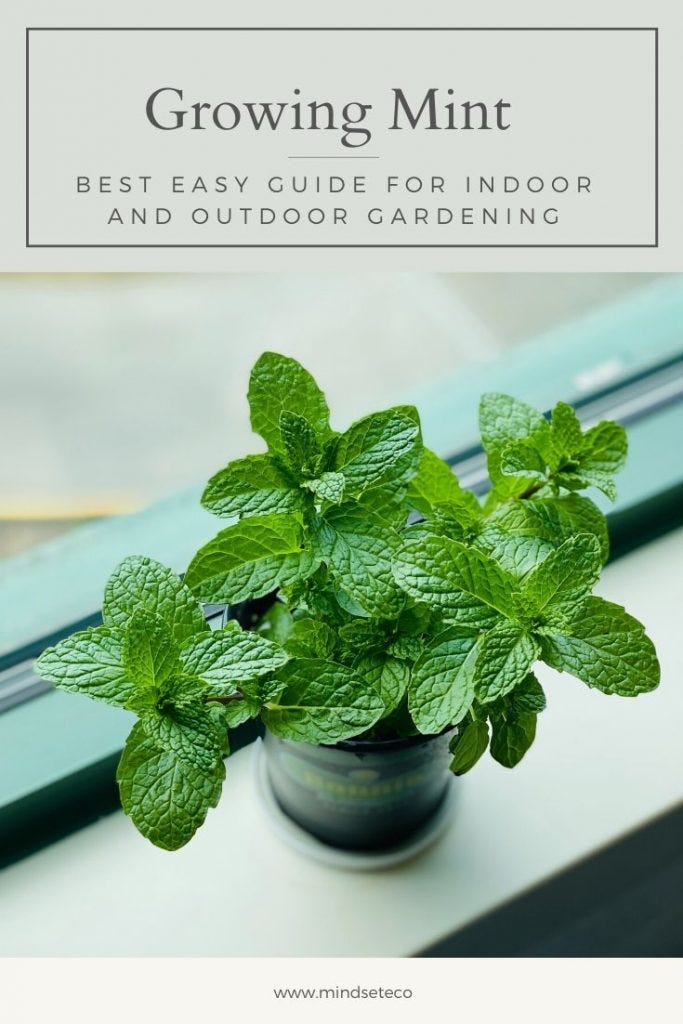
Benefits and uses of mint
A robust and hardy perennial, Mint (Mentha spp.) flourishes in most climates, both indoors and outdoors, with minimal attention.
Mint is an herb belonging to the Labiatae family, which includes other culinary staples like Sage, Rosemary, Thyme and Basil.
True to its heritage, Mint is a wonderfully versatile plant with many, many culinary uses. It's distinctive, zesty flavour and fresh, minty fragrance, work well with just about anything! A culinary gem, it is used in:
Fresh green salads
Fresh fruit salads
Green juices and smoothies
Jellies and sauces
Summer Cocktails (think iced Mojitos and Mint Juleps)
Teas, like Mint and Lemon Tea or as an added flavour in herbal teas
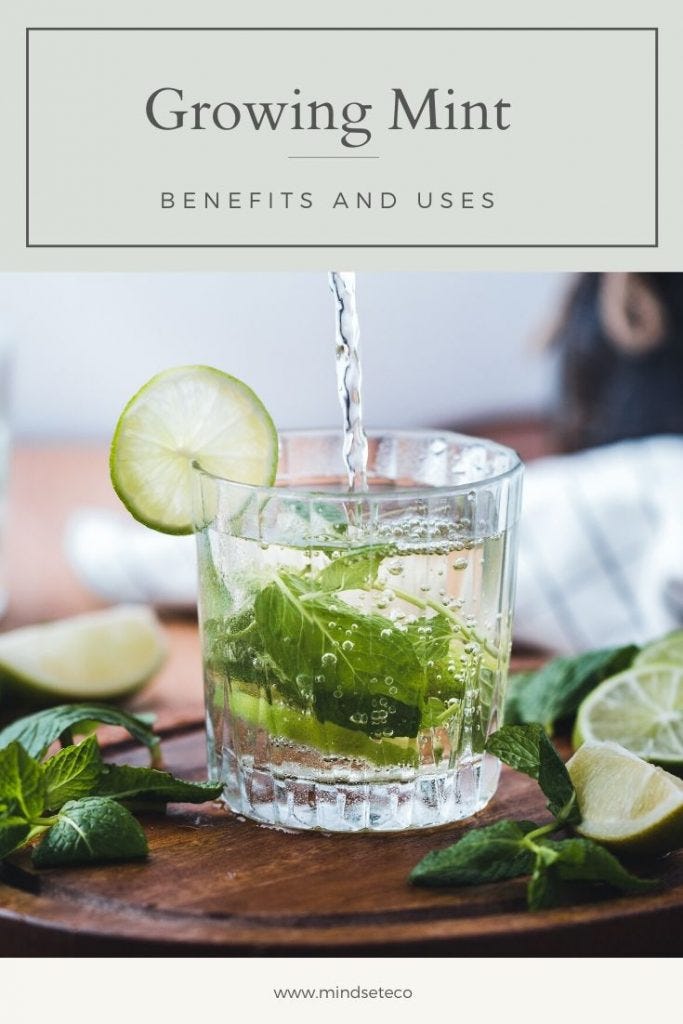
Image by Healthyreciperian on Instagram
The plant is naturally rich in antioxidants, which actively fight oxidative stress and the cell damage caused by free radicals. It is also an excellent source of Vitamin A, which is essential for eye health and night vision.
Mint, especially Peppermint, is widely used in home remedies for:
Indigestion
Cold and flu symptoms
Bacterial infections and bad breath
Irritable Bowel Syndrome
Skin irritation and insect bites
Muscle aches
Mental fatigue and improved cognitive function
There are many different varieties of Mint. The most frequently used ones are Spearmint and Peppermint.
Spearmint is best for savory dishes and hot drinks; it has a sweet, full-bodied flavor and gentle fragrance.
Peppermint is better for the sweeter flavors in chilled drinks, smoothies and desserts. It has a crisper, stronger flavor and the fragrance is pungent, with more menthol to it. The menthol in Peppermint makes it ideal for home remedies.
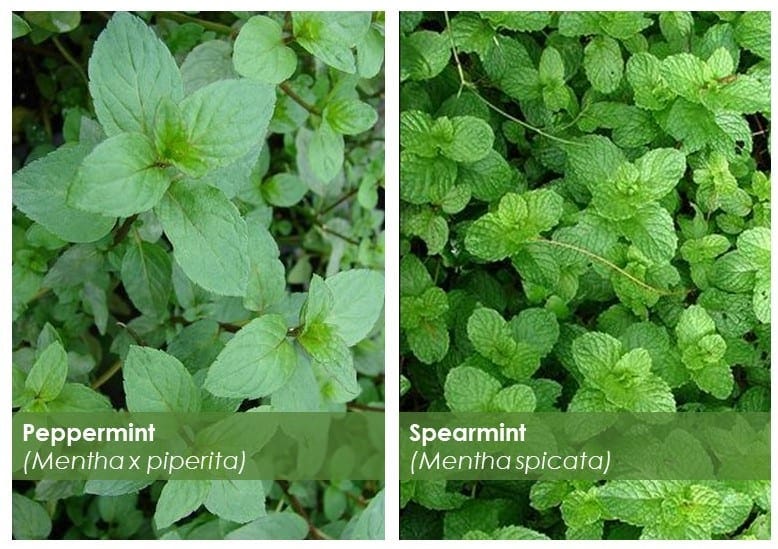
Peppermint vs Spearmint - Images via NC State University
There are also many other kinds of Mint, including Apple Mint, Chocolate Mint and the beautiful variegated Pineapple Mint.
Ready to get growing? Let's look at how to get the best from your Mint at home!
Ideal Growing Conditions for Mint
The ideal climate for Mint is one with warm sunny days and cooler nights. Mint needs to be well watered, therefore it will do better in tropical and subtropical climates rather than particularly dry and arid regions.
Outdoors
Mint will tolerate light frost and full sun, as long as it has some protection from extremes in temperature. It is generally a hardy plant so you don't need to fuss too much about, once you have the basics right.
Choosing the right spot for your Mint is an important step, so look for a spot:
in full sun to partial shade (variegated varieties need more shade)
with soil that drains well
where there is good air movement
there is some kind of barrier around the mint to stop it spreading like fresh, Minty, wildfire!
Mint is a shallow rooted plant that spreads rapidly, so it's best to have a physical barrier around it. Placing it between a walkway and a wall, or surrounding it with rock work or landscape edging, will contain it.
Alternatively, plant it in a container or raised garden bed where it can flourish freely without taking over.
Check out the video below for a DIY tutorial to make your own raised garden beds:
Video tutorial on DIY Raised Garden Beds by homesteadonomics via YouTube
Indoors
Planted indoors, Mint thrives in a position with direct sunlight for several hours and good, bright, light for the rest of the day. Mint will also do well on a covered patio or balcony.
It does best in areas with good air flow, that are somewhat protected, especially in very damp and humid or very dry, arid climates.
Mint needs to be watered regularly so make sure your plant is easily accessible for watering (and harvesting!).
Soils
Mint thrives in moist, rich soil that drains well and doesn't become water logged.
A rough guide to achieving the perfect soil for container planting is to make your own medium by mixing:
Potting soil (40%)
Organic compost (30%)
Perlite or sand (30%)
If you are planting directly into the garden, check the soil texture and quality before you plant. Dry, crumbly soils will benefit from compost or mulch and smooth, moist, clay soils will benefit from adding sand.
Containers
Mint does well in wider, shallower containers because it does not root very deeply and tends to spread out, horizontally.
Make sure the containers have holes in the base for drainage and to prevent the soil from becoming water logged. Put some stones in the bottom of the container so that the drainage holes don't get clogged up with wet soil.
Mint will grow to between 30 cm and 60 cm high. It bushes out with full, thick foliage so bear that in mind when you choose your containers, especially if they are going indoors and space is a consideration
How to Plant Mint
Once you have selected your container or your spot in the garden, planting Mint is wonderfully easy!
You need to have soil that is moist and loosely compacted.
Make a hole just deep enough to cover the roots, while still keeping the stem upright.
Place it into the hole and gently pack some soil over the roots and around the stem.
Water your Mint well, immediately after planting.
Mint grows quickly and seeds will reach maturity within about 90 days from germination. Cuttings mature sooner, in approximately 30 to 40 days. Mature Mint plants are 30 cm to 60 cm high.
Mint grows fast and spreads rapidly by sending out runners that root themselves into the soil around the mother plant. This means that Mint in containers will need to be split and re-potted to keep it healthy and prevent it becoming root bound.
Remove the plant from the pot, tease apart the roots to separate the plant into segments, comprising individual 'clumps' of stems and roots. Plant them out into the ground or into different containers.
You can buy ready-to-plant Mint plants from any garden center or nursery. However, Mint is also very easy to grow from seed, or propagate from stem cuttings.
How to Grow mint from Cuttings
Growing Mint from cuttings is easy and there is something so rewarding about seeing your little plants grow roots and new leaves right in front of you!
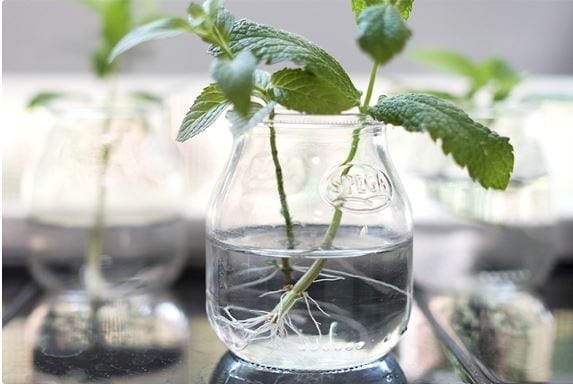
Image from Emily Han via Learning Herbs
For the best results:
Choose green stems with healthy leaves
Cut them about 10 cm from the tip. Strip off the lower leaves so that you are left with about five to eight leaves at the tip (about three layers of leaves).
Trim the stems by cutting them immediately below a node (leaf joint), as this is the area with the most growth potential for new roots.
Pop the cut stems into a glass of fresh water and leave it in a warm, well-lit place (6 to 8 hours of sunlight a day).
Replace the water every three to four days.
Within a week or so, little white roots will start to grow from the stems. In a few more days, some tiny leaves new will start to bud. That's it! You have successfully created a whole new plant!
Leave the cuttings in water a little longer, so that the roots can grow and establish themselves and then plant the cuttings into soil.
How to Grow Mint from Seed
To grow Mint from seed you will need to create a rich and well-draining growing medium. The potting soil, compost and perlite/sand mixture we mentioned above is perfect for seeds too.
Loosely fill a wide, shallow container with your growing medium and reserve some to sprinkle over the seeds (about 1 cm deep).
Moisten the soil thoroughly and give it a minute for any excess water to drain away.
Now sprinkle the Mint seeds over the top, taking care to scatter the seeds loosely, with some space between them.
Sprinkle the remaining soil mixture on top of the seeds, about 1 cm thick, and gently pat it down with your hand to settle the seeds.
Place your container indoors, in a spot where it will get morning sun and afternoon shade. Keep the soil moist. Do not cover the container as the seeds need sunlight to germinate.
The first seeds will germinate and sprout in the first seven to ten days but others will take as long as 30 days to sprout.
Once the little seedlings have two or three leaves, they are ready to plant.
Mint seeds can be plant seeds throughout the year indoors or in the spring, summer and early autumn outdoors.
Baby seedlings are fragile so it?s best to give them some time to transition if they?re going to move from inside to outside. Move their container out but keep it protected and in semi-shade for a few days, so they can adapt to their new conditions.
Time lapse clip of Peppermint seeds sprouting by TimeLapser Jekyl
How to Grow Mint in Water
Mint will grow well in water. It needs a little more attention in water than it does in soil because you need to make sure you're giving it the nutrients it would be getting from the soil. To keep your Mint happy in water:
Change the water every three or four days. Use fresh tap water or, for the best results, collect rain water for them.
Use a pinch of water-soluble fertilizer every two or three weeks (more frequently if the leaves are looking a little yellow).
Growing plants directly in water results in more humidity around the plant, so harvest it often to thin out the leaves and allow for good air circulation.
Keep your Mint in a sunny position, with several hours of direct sun and good, bright light the rest of the day.
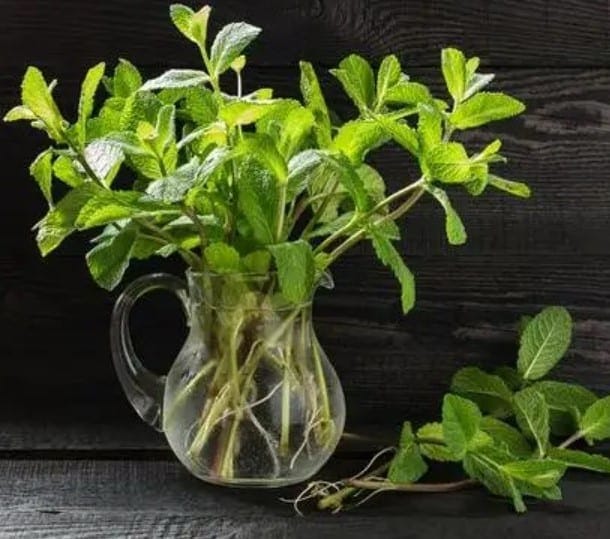
Image from DIY Natural
How to Care for Your Mint Plants
Mint is a hardy plant that doesn't ask for much. Give it the basics and a healthy foundation and it will simply thrive! Take care of its basic needs and the plant will do the rest:
Soil - Mint does best in rich, moist, soil that drains well. Avoid shale and clay soils. If you need to, add compost or sand as needed to improve the soil condition.
Water - Mint loves water! Water it regularly (every three or four days). Stick your finger into the soil at the base of the plant, up to the second knuckle, and if the soil is dry it needs watering. Water thoroughly but make sure the container is draining well and there is no water logging.
Pruning - Prune it right back during the winter, when the plant is dormant. Cutting out and remove all the older, woody, stems to produce plenty of fresh new growth in the spring. Throughput the rest of the year, it can be cut back and shaped as needed. If you harvest often, pruning during the spring and summer won?t be necessary.
Fertilizing - If Mint is grown in good soil, it does not require frequent of feeding. However, if your plants are looking a little sad or yellowed, feed with an all-purpose, water-soluble, plant food. Mint grown in containers will need to be fed about once a year, in the early spring, to replenish the nutrients in the soil.
Pests and Diseases
Mint is not easily susceptible to pests and diseases. However, if you need to, it is best to manually remove bugs and affected leaves rather than using any chemicals or soap solutions.
Pulling any bitten leaves off and/or manually picking off any little critters you see is usually the easiest and safest method to deal with pests like slugs, snails or caterpillars.
Mint is susceptible to Aphids, which can be trickier to treat, but spraying the plants with water from a spray bottle or hose will dislodge them and wash them away.
If manual means don't do the trick, there are other safe and natural ways to treat your Mint. A mixture of Neem oil and other essential oils will target Aphid adults and larvae, as well as some fungus and bacteria.
If you see any spots or discolored patches, pulling those leaves off will prevent the spread of any bacterial or fungal infections. Letting the plant dry out well before the next watering and thinning the foliage out, to ensure air circulation, will also help.
How to Harvest Mint
To harvest Mint, you can pick off the greenest, newest leaves by hand or clip the stems a little lower down for whole sprigs of Mint.
Clipping the stems in the green, supple portion of the stem encourages new growth so you can harvest again and again!
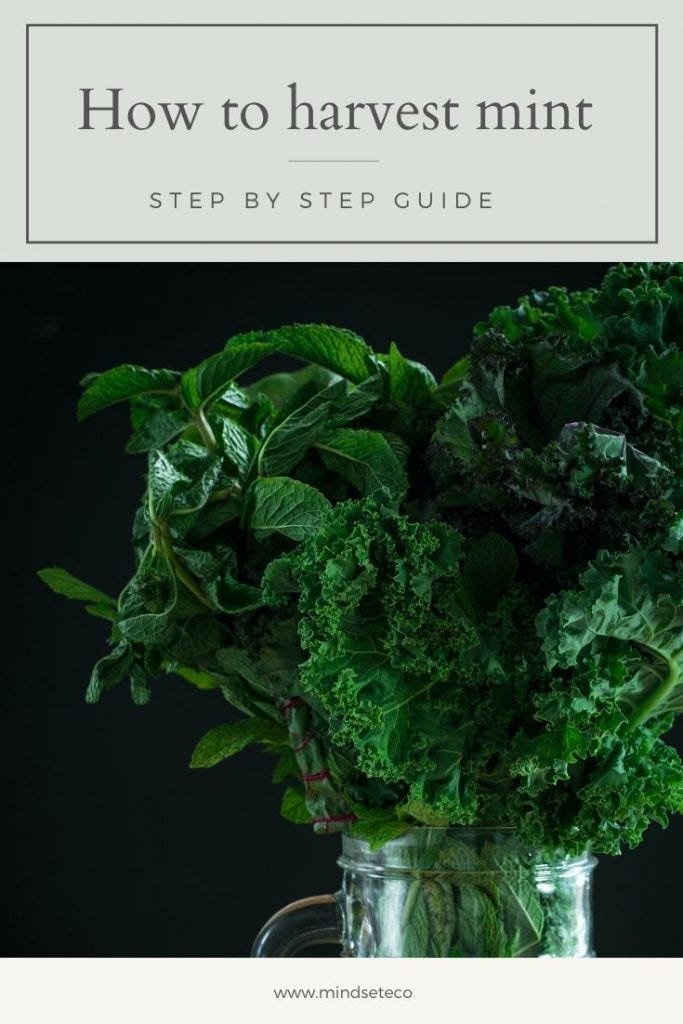
How to Store Your Mint After Harvesting
Mint can be kept fresh for two or three days, in a glass of water in the fridge. You can also dry it or freeze it, to keep it for longer periods of time.
Freezing
To freeze Mint:
Harvest your fresh mint from the plant
Remove the leaves from the stems and loosely chop them.
Place them into an ice tray and cover them with water and freeze.
Remove the frozen cubes from the trays and store them in a container, freezer bag or Beeswax Wrap for up to three months.
Use frozen Mint in place of fresh Mint by thawing and draining it. Frozen cubes of Mint also make beautiful and flavourful ice cubes for water or cold drinks. Use frozen cubes directly into the juicer or blender for smoothies.

Image by Anna Shepulova via The Old Farmer's Almanac
Drying
To air dry Mint:
Loosely bunch and tie several sprigs together
Hang them upside down in a cool, dry and dark place
Make sure that air can freely circulate around the leaves
Once they are completely dehydrated and crumbly, separate them from the dry stems and store them in an airtight container. Mint can also be dried in the oven, on the lowest setting, between two sheets of paper towel.
Conclusion
Mint is a wonderfully versatile herb that is easy to grow, care for and harvest. The uses and benefits of Mint are endless and it is an absolute gem to have in the house!
Check out the following links for inspiration and easy recipes:
Mint Julep Cocktail: https://www.thespruceeats.com/classic-mint-julep-recipe-759323
Mint Smoothie Recipes: https://greenblender.com/smoothies/5609/mint-smoothie-recipes
Easy Fresh Mint Tea: https://perchancetocook.com/2018/01/25/easy-fresh-mint-tea-paleo-gf/
DIY Beeswax and Peppermint Oil Lip Balm: https://livingwellmom.com/easy-3-ingredient-diy-peppermint-lip-balm/
Resources
Growing Mint: https://www.almanac.com/plant/mint
How to Start Your Own Herb Garden: https://gardenerspath.com/plants/herbs/grow-herbs/
Easy DIY Raised Beds: https://gardenerspath.com/how-to/greenhouses-and-coldframes/build-diy-raised-beds/
How to Grow Mint: https://harvesttotable.com/how_to_grow_mint/
Grow an Endless Supply of Herbs from Cuttings: https://learningherbs.com/skills/herbs-from-cuttings/
21 Ways to Use Mint: https://www.naturallivingideas.com/21-ways-to-use-mint/
Health Benefits of Mint: https://www.healthline.com/nutrition/mint-benefit



